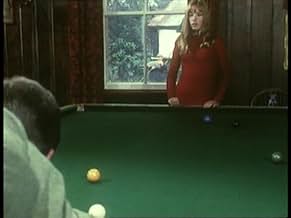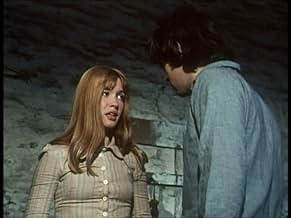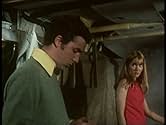Agrega una trama en tu idiomaThree teenagers discover a mysterious set of owl and flower-patterned dinner plates in the attic and the magical ancient legend of the "Mabinogion" comes to life once again in their Welsh va... Leer todoThree teenagers discover a mysterious set of owl and flower-patterned dinner plates in the attic and the magical ancient legend of the "Mabinogion" comes to life once again in their Welsh valley.Three teenagers discover a mysterious set of owl and flower-patterned dinner plates in the attic and the magical ancient legend of the "Mabinogion" comes to life once again in their Welsh valley.
Explorar episodios
Opiniones destacadas
An 8-part TV series that includes a supernatural theme based on folklore, murder, (hinted, off-screen) sex, and demonic possession.
So perfect Sunday teatime viewing for all the family in 1970, with the first episodes being shown just before Christmas 1969.
No need to go into the story too much. It is retelling/updating/"inspired by" story based on a tale from the Mabinogion by acclaimed children's author Alan Garner, who was heavily involved in this TV version of his novel (and as a result it is a very faithful version). It features three young people (probably meant to be aged around 15-16) in an emotional triangle (to call it a love triangle would be misleading), living in a Welsh manor house in a valley cut off from the outside world (no electricity, phone, etc. - which was entirely plausible for the late 60s/early 70s).
The discovery of a strange dinner service results takes over the young girl - Alison - (played very well by an actress some 10 years older than the part she is playing) who is compelled to trace the pattern on the plates and make paper owls. And so the story begins.
After this it gets quite complex - to the extent that the summary of the previous episode that starts episodes 2-8 is absolutely required viewing, even if you are binging the entire series (its available on YouTube) because you will have missed something!
The three young actors (though they are significantly older than the parts they play) do a great job holding together a tale that basically only has six parts in it (the others being the father of two of the children, a live-in housekeeper and mother of the third, and a strange and apparently a little mad handyman/gardener.
Spread over 8 25-minute episodes the story will seem a little slow to modern viewers, with not a great deal of action (you can literally count the number of spots of blood that are shown), but what is hinted at and what probably happens off camera is another matter entirely.
Perhaps this is where the family viewing comes in because adult viewers will likely get the hints that children will miss, such as - to take one fairly mild example - why is Alison "ill" and in bed at the start, in her red nightdress, despite actually appearing quite perky? Not that hard for an adult to guess.
Each episode pushes the story forward with the last one being quite strong stuff, with what is essentially a form of demonic possession centre screen. A suspect a few viewers choked on the Sunday tea when this was shown.
But it is not just the story that would raise eyebrows - and actually make this unfilmable today (for children anyway) - it is also the style of filming. There may be little blood, but the camera loves Alison's legs in their 1960s short skirts to an extent that would be very worrying if you did not know that the actress was 25.
Overall this is a dark, complex, difficult but brilliant drama that uses folklore and the supernatural in a way that would be utterly impossible for the target audience today.
So perfect Sunday teatime viewing for all the family in 1970, with the first episodes being shown just before Christmas 1969.
No need to go into the story too much. It is retelling/updating/"inspired by" story based on a tale from the Mabinogion by acclaimed children's author Alan Garner, who was heavily involved in this TV version of his novel (and as a result it is a very faithful version). It features three young people (probably meant to be aged around 15-16) in an emotional triangle (to call it a love triangle would be misleading), living in a Welsh manor house in a valley cut off from the outside world (no electricity, phone, etc. - which was entirely plausible for the late 60s/early 70s).
The discovery of a strange dinner service results takes over the young girl - Alison - (played very well by an actress some 10 years older than the part she is playing) who is compelled to trace the pattern on the plates and make paper owls. And so the story begins.
After this it gets quite complex - to the extent that the summary of the previous episode that starts episodes 2-8 is absolutely required viewing, even if you are binging the entire series (its available on YouTube) because you will have missed something!
The three young actors (though they are significantly older than the parts they play) do a great job holding together a tale that basically only has six parts in it (the others being the father of two of the children, a live-in housekeeper and mother of the third, and a strange and apparently a little mad handyman/gardener.
Spread over 8 25-minute episodes the story will seem a little slow to modern viewers, with not a great deal of action (you can literally count the number of spots of blood that are shown), but what is hinted at and what probably happens off camera is another matter entirely.
Perhaps this is where the family viewing comes in because adult viewers will likely get the hints that children will miss, such as - to take one fairly mild example - why is Alison "ill" and in bed at the start, in her red nightdress, despite actually appearing quite perky? Not that hard for an adult to guess.
Each episode pushes the story forward with the last one being quite strong stuff, with what is essentially a form of demonic possession centre screen. A suspect a few viewers choked on the Sunday tea when this was shown.
But it is not just the story that would raise eyebrows - and actually make this unfilmable today (for children anyway) - it is also the style of filming. There may be little blood, but the camera loves Alison's legs in their 1960s short skirts to an extent that would be very worrying if you did not know that the actress was 25.
Overall this is a dark, complex, difficult but brilliant drama that uses folklore and the supernatural in a way that would be utterly impossible for the target audience today.
This was originally a Sunday evening children's programme. Some people found the plot hard going. However this does not distract from beautifully filmed,mystic quality of the programme. As a video release this would ideal, enabling it to be digested in your own time. Could be Gillian Hills' finest hour?
This is simply one of the finest children's TV series ever made! Yes, I really do mean that. It harks back to a age of nostalgia and lost times. So many wonderful memories of me as a very young child watching this. The vintage age of children's TV was the late 60s too around 1980.oh,and to the reviewers who only gave this one star and complaining about the actors ages and production, it was 1969!and you obviously don't have a clue what you are watching. Some people just like to belittle for the sake of it.
Strange that reviewers' opinion about this series is split, in that there is very little of merit in here at all, beyond Edwin Richfield's trademark twitchiness. It is extremely slow, stretched to breaking point across four hours. The three juvenile leads are extraordinarily inept and equally thumpable (well, maybe Roger is marginally worse than the others). Eerie moments are not followed up, so their effects dissipate. Mysteries are raised and never resolved. Bafflingly, the character Margaret, who is fairly crucial, is never shown; even the DVD notes fail to explain why. Some scenes have to go to enormous lengths to work around her absence; even a cardboard cut-out in silhouette would have been preferable. It is not stylish; the camera is generally static and the editing plodding. And the resolution, when it comes, resolves very little, choosing instead to wrap it all up in sci-fi gobbledegook.
And yet somehow it has become a cult classic. Go figure.
And yet somehow it has become a cult classic. Go figure.
I think I'm one of maybe two Americans who have seen this (the other being Steve Puchalski of "Shock Cinema" magazine on whose recommendation I recently bought this DVD, sight unseen, from Amazon UK). This short-lived but fondly remembered British TV series is a very offbeat, supernatural mystery set in the Welsh countryside revolving around a set of dinner plates (that's right--dinner plates) that a step-brother and sister and their housekeeper's son find in the attic of a country cottage. It's a low-budget and (especially by today's standards) low-key affair, but it is nevertheless effective and interesting, at times even unsettling.
You could compare it to the offbeat, unsettling American TV series "Twin Peaks",I guess, but it really has indelible elements of 60's era BBC programming and high-quality children's literature (it was based on a children's book). I personally enjoy all of these things, and being one quarter Welsh, I find Welsh mythology very interesting (although I have to say the Welsh countryside is actually one of the most boring places I've ever visited).
Due to it's roots in children's literature and television, this is obviously not chock-full of sex or violence. But what the mild violence it contains is eerily unsettling, and there is kind of a teen love triangle that is rather perverse in that two of it's members are step-brother and step-sister. Moreover, the step-sister is played by Gillian Hills, a gorgeous 60's-era, Swinging London dolly-bird who is most famous for a pair of three-way sex scenes in two classic movies of that era (with David Hemmings and Jane Birkin in "Blow Up" and with Malcolm McDowell and some other actress in "A Clockwork Orange"). She almost can't help, but bring SOME sex appeal to the proceedings. Still, by modern-day standards this is very tame and rather slow. But I liked it simply because it was offbeat and interesting, and not really like ANYTHING I'd ever seen before.
You could compare it to the offbeat, unsettling American TV series "Twin Peaks",I guess, but it really has indelible elements of 60's era BBC programming and high-quality children's literature (it was based on a children's book). I personally enjoy all of these things, and being one quarter Welsh, I find Welsh mythology very interesting (although I have to say the Welsh countryside is actually one of the most boring places I've ever visited).
Due to it's roots in children's literature and television, this is obviously not chock-full of sex or violence. But what the mild violence it contains is eerily unsettling, and there is kind of a teen love triangle that is rather perverse in that two of it's members are step-brother and step-sister. Moreover, the step-sister is played by Gillian Hills, a gorgeous 60's-era, Swinging London dolly-bird who is most famous for a pair of three-way sex scenes in two classic movies of that era (with David Hemmings and Jane Birkin in "Blow Up" and with Malcolm McDowell and some other actress in "A Clockwork Orange"). She almost can't help, but bring SOME sex appeal to the proceedings. Still, by modern-day standards this is very tame and rather slow. But I liked it simply because it was offbeat and interesting, and not really like ANYTHING I'd ever seen before.
¿Sabías que…?
- TriviaAs the first fully scripted colour production by Granada Television, the series takes full advantage of the color red, not only in the form of Gillian Hills's stunning red hair, but her wardrobe is almost entirely made up of red miniskirts, bikinis, hats and raincoats.
- ConexionesFeatured in The Worlds of Fantasy: The Child Within (2008)
- Bandas sonorasTon Alarch
Performed by Jean Bell
[closing music for each episode]
Selecciones populares
Inicia sesión para calificar y agrega a la lista de videos para obtener recomendaciones personalizadas
- How many seasons does The Owl Service have?Con tecnología de Alexa
Detalles
Contribuir a esta página
Sugiere una edición o agrega el contenido que falta

Principales brechas de datos
By what name was The Owl Service (1969) officially released in India in English?
Responda





















